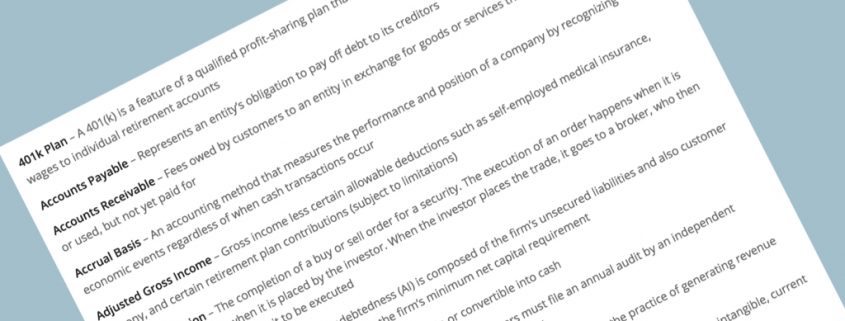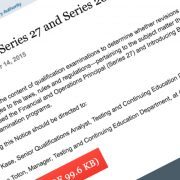Financial Accounting & FinOp Glossary
ACI has prepared this alphabetical list of definitions for the most commonly used terms in Financial Accounting.
401k Plan – A 401(k) is a feature of a qualified profit-sharing plan that allows employees to contribute a portion of their wages to individual retirement accounts
Accounts Payable – Represents an entity’s obligation to pay off debt to its creditors
Accounts Receivable – Fees owed by customers to an entity in exchange for goods or services that have been delivered or used, but not yet paid for
Accrual Basis – An accounting method that measures the performance and position of a company by recognizing economic events regardless of when cash transactions occur
Adjusted Gross Income – Gross income less certain allowable deductions such as self-employed medical insurance, alimony, and certain retirement plan contributions (subject to limitations)
Agency Execution – The completion of a buy or sell order for a security. The execution of an order happens when it is completely filled, not when it is placed by the investor. When the investor places the trade, it goes to a broker, who then determines the best way for it to be executed
Aggregate Indebtedness – Aggregate indebtedness (AI) is composed of the firm’s unsecured liabilities and also customer related liabilities. AI has a direct correlation to the firm’s minimum net capital requirement
Allowable Assets – Firm’s assets that are readily available or convertible into cash
Annual Audit – Broker dealers that do business with public customers must file an annual audit by an independent certified public accountant within 60 calendar days after its fiscal year end
Anti-Money Laundering (AML) – Laws, procedures and regulations designed to stop the practice of generating revenue from illegal activity
Asset – An item of economic value that can be found on a company’s balance sheet; could be tangible, intangible, current or long term, prepaid or deferred;
Assets Under Management (AUM) – The market value of assets that an investment company manages on behalf of investors. Assets under management (AUM) is looked at as a measure of success against the competition and consists of growth/decline due to both capital appreciation/losses and new money inflow/outflow
Balance Sheet – A financial statement that summarizes a company’s assets, liabilities and shareholders’ equity at a specific point in time
Bank Reconciliation – A report that compares the bank balance as per the company’s accounting records with the balance stated in the bank statement
Broker Dealer – A person or firm in the business of buying and selling securities, operating as both a broker and a dealer, depending on the transaction. The term broker-dealer is used in U.S. securities regulation parlance to describe stock brokerages, because most of them act as both agents and principals. A brokerage acts as a broker (or agent) when it executes orders on behalf of clients, whereas it acts as a dealer (or principal) when it trades for its own account
Buy Side – The side of Wall Street comprising the investing institutions such as mutual funds, pension funds and insurance firms that tend to buy large portions of securities for money-management purposes
C Corporation – A type of business legal structure. C Corporations are considered separate entities from their owners. Income is taxed on the corporate level and is taxed again when it is distributed to owners
Capital Gain – An increase in the value of a capital asset. Capital gains could be realized or unrealized, short or long term
Capital Loss – Decrease in the capital asset value compared to an asset’s purchase price.
Cash Basis – An accounting method that recognizes revenues and expenses at the time cash is physically collected or disbursed
Central Registration Depository (CRD) – The central licensing and registration system for the U.S. securities industry and its regulators. It contains the registration records of registered broker-dealers and the qualification, employment, and disclosure histories of active registered individuals
Chief Compliance Officer (CCO) – Compliance personnel who overseas and manages compliance within an organization. His/her primary role is to ensure that the firm complies with applicable regulatory requirements and internal policies and procedures
Chief Financial Officer (CFO) – Financial personnel who oversees the financial activities of a company. The CFO’s duties include financial planning and monitoring of cash flow. He/she analyzes the company’s financial strengths and weaknesses and suggests plans for improvement
Clearing Firm – Most broker dealers have a clearing or “carrying” firm relationships. The firm not only handles the BD’s orders to buy and sell securities, but it also maintains custody of the securities and other assets (like any cash in the BD’s account)
Commission Sharing – Form of revenue sharing arrangement between broker dealers
Deferred Revenue – Advance payments or unearned revenue, recorded on the recipient’s balance sheet as a liability, until the services have been rendered or products have been delivered. Deferred revenue is a liability because it refers to revenue that has not yet been earned, but represents products or services that are owed to the customer. As the product or service is delivered over time, it is recognized as revenue on the income statement
Depreciation – A method of allocating the cost of a tangible asset over its useful life. Businesses depreciate long-term assets for both tax and accounting purposes
Dividend Income – A distribution of a portion of a company’s earnings, decided by the board of directors, to a class of its shareholders
Electronic Filing (E-Filing) – The process of submitting regulatory reports via an electronic system created by FINRA
Equity – A stock or any other security representing an ownership interest
Expense – The economic costs that a business incurs through its operations to earn revenue
FICA (Federal Insurance Contributions Act) – Federal tax imposed on employer and employee (in order to fund Social Security and Medicare.)
Financial and Operations Principal (FinOp) –A Financial Principal is the individual involved in the preparation and maintenance of financial reporting for a registered Broker Dealer. All FinOps must be registered with a Broker Dealer and must hold Series 27/28 license, which they can obtain by successfully passing a FINRA examination . FinOps are responsible for the accuracy and final approval of financial reports such as Financial and Operations Combined Uniform Single Report (FOCUS Report). They are also responsible for ensuring that firms are in compliance with FINRA Net Capital, record keeping and customer protection rules and regulation
FINRA – Financial Industry Regulatory Authority is an independent, not-for-profit organization authorized by Congress to protect America’s investors by making sure the securities industry operates fairly and honestly. FINRA is dedicated to investor protection and market integrity through effective and efficient regulation of the securities industry
Fiscal Year – A period that a company uses for accounting purposes. The fiscal year may or may not be the same as a calendar year. For tax purposes, companies may choose to be calendar-year taxpayers or fiscal-year taxpayers
FOCUS Report (Form X-17a-5) – All broker dealers are required to file Financial Operations Combined Uniform Report (Focus Report) with FINRA and SEC on either a monthly or quarterly basis. The Focus Report serves as the final product of a broker dealer’s financial activities over a period of time designated by FINRA. It provides detailed information about the firm’s financial status. FOCUS Reports must be e-filed with FINRA by the 17th business day of the month
Form 1017 – Uniform Application for change in ownership, control or business operations by a registered broker-dealer
Form 1040 – U.S. individual federal income tax return filed with the IRS
Form 1065 – A tax document used to report the profits, losses and deductions of a partnership. Schedule K-1 is a part of Form 1065, and is prepared for each individual partner. The document identifies the percentage share of profit and loss assigned to each partner, both at the beginning of the reporting period and at the end
Form 1099 – A tax document which is used to report various types of income other than wages, salaries and tips. Usually this form is used to report compensation to independent contractors
Form 1120 – A tax document used to report the profits and losses of a C corporation
Form 1120S – The tax return used to report the profits and losses of an S corporation; it is an S corporation’s tax return. Schedule K-1 is a part of Form 1120S. It is prepared for each individual shareholder and identifies the percentage of ownership for each shareholder as well as the reportable income and expenses passed through to each shareholder during the year
Form Custody – A form broker dealers are required to submit to FINRA indicating their procedures regarding the receipt of customer funds and/or securities
Form U-4 – Uniform Application for Securities Industry Registration
Form U-5 – Uniform Termination Notice for Securities Industry Registration
Form W-2 – Federal Tax Form issued by the employer stating the yearly salary of an individual
Form W-4 – A Federal tax Form provided by individuals to their employer so proper taxes are withheld from their pay
General Ledger – A company’s primary accounting record. The general ledger details the transactional activity of the firm and acts as support for the financial statements
Generally Accepted Accounting Principles (GAAP) – The common set of accounting principles, standards and procedures imposed on companies when they prepare financial statements
Gross Revenue – The amount of money that a company earns during a specific period. It is the “top line” or “gross income” figure from which costs are subtracted to determine net income
Haircut – The percentage by which an asset’s market value is reduced for the purpose of calculating capital requirement, margin and collateral levels
Income Statement – A financial statement that measures the financial performance of a company for a specific period of time. Also known as Profit and Loss Statement
Income Tax – Government tax imposed on taxpayers (individuals or corporations)
Institutional Investor – An organization that trades securities in large quantities
Intangible Asset – An asset that is not physical in nature such as goodwill, brand recognition and trademarks
Interest Income – Reported on the firm’s profit and loss statement, represents interest earned such as interest on cash held in a savings account
Investment Banking – A specific division of banking related to the creation of capital for other companies
Liability – A company’s legal debts or obligations that arise during the course of business operations. Liabilities are settled over time through the transfer of economic benefits including money, goods or services
Limited Liability Company – A corporate structure whereby the members of the company cannot be held personally liable for the company’s debts or liabilities. While the limited liability feature is similar to that of a corporation, the availability of flow-through taxation to the members of a LLC is a feature of partnerships
Margin – Borrowed money that is used to purchase securities. This practice is referred to as “buying on margin”
Market Making – An action whereby a dealer stands by ready, willing and able to buy or sell a particular security at the quoted bid and ask price
Net Capital – Net Capital is the “liquid net worth” of a broker dealer. It is computed by adjusting the equity of the broker dealer by any subordinated liabilities, non-allowable assets, or capital haircuts
Net Capital Requirement – The Net Capital Rule sets minimum dollar requirements for broker dealers’ net capital depending on the type of business in which the broker dealer is engaged
Net Income – A company’s total earnings (or profit). Net income is calculated by taking revenues and adjusting for the cost of doing business, depreciation, interest, taxes and other expenses. This number is found on a company’s income statement and is an important measure of how profitable the company is over a period of time
New Member Application – The application submitted to FINRA for acceptance as a broker dealer member firm
Non-Allowable Asset – An asset that is not readily convertible into cash. For net capital purposes, it reduces the firm’s net worth. Such assets could be accounts receivable that are not collected within 30 day period
Parent Entity – A company that controls other companies through ownership and influential amount of voting stock. Typically larger firms that have control over one or more small business subsidiaries
Payroll Taxes – Government tax imposed on employers and employees, usually calculated based on the individuals’ compensation
Prepaid Expense – An asset of the firm on its balance sheet as a result of making a payment for goods and/or services to be received in the future
Proprietary Trading – When a firm trades for direct gain or loss instead of commission dollars. Essentially, the firm has decided to profit from the market rather than from commissions from processing trades
Registered Investment Advisor – An advisor or firm engaged in the investment advisory business and registered either with the Securities and Exchange Commission (SEC) or state securities authorities. A Registered Investment Advisor is defined by The Investment Advisers Act of 1940 as a “person or firm that, for compensation, is engaged in the act of providing advice, making recommendations, issuing reports or furnishing analyses on securities, either directly or through publications.” An investment advisor has a fiduciary duty to his or her clients, which means that he or she has a fundamental obligation to provide suitable investment advice and always act in the clients’ best interests
Registered Representative – A person who works for a broker dealer, is licensed by the Securities and Exchange Commission (SEC) and acts as an account executive for clients trading investment products such as stocks, bonds and mutual funds
Retail Brokerage – The service of providing brokerage to customers who are retail individual investors rather than institutional investors
Retail Investor – An individual who buys and sells securities for their personal account rather than an organization
S Corporation – A legal entity under Subchapter S of the Internal Revenue Code. Any profits or losses earned by the corporation are not taxed at the corporate level, but at the level of the shareholders.
SEC – Securities and Exchange Commission is the governmental body that holds primary responsibility for enforcing the federal securities laws and regulating the securities industry
Secured Demand Note – Under this arrangement, the lender gives marginable securities to the Broker Dealer. The broker dealer can use these securities (subject to haircut rules) to enhance the firm’s net capital
Securities and Exchange Commission (SEC) – A government commission created by Congress to regulate the securities markets and protect investors. The statutes administered by the SEC are designed to promote full public disclosure and to protect the investing public against fraudulent and manipulative practices in the securities markets
Securities Investor Protection Corporation (SIPC) – A nonprofit corporation created by an act of Congress to protect the clients of brokerage firms that are forced into bankruptcy. Members to the SIPC include all brokers and dealers registered under the Securities Exchange Act of 1934, all members of securities exchanges and most NASD members. Payments to SIPC are computed and owed semi-annually by all broker dealer member firms
Security – A financial instrument that represents the ownership of a publicly traded corporation
Sell Side – The part of the financial industry involved with the creation, promotion, analysis and sale of securities. Sell-side individuals and firms work to create and service stock products that will be made available to the buy side of the financial industry. The sell side of Wall Street includes investment bankers who serve as intermediaries between issuers of securities and the investing public, analysts who perform stock research and make ratings, and the market makers who provide liquidity in the market
Series 7 – A general securities registered representative license administered by the Financial Industry Regulatory Authority (FINRA) that entitles the holder to sell all types of securities products with the exception of commodities and futures
Series 24 – A compliance securities license entitling the holder to supervise and manage branch activities. Before taking the Series 24 exam, an individual must possess the Series 7 license
Series 27 – A securities license entitling the holder to become a chief financial officer for a FINRA member firm. The Series 27 exam is a FINRA exam designed to challenge the test taker’s knowledge of issues related to CFO responsibilities, such as statutory rules surrounding broker-dealer responsibilities, and items covered under the Securities Investor Protection Act of 1970
Series 63 – A securities license entitling the holder to solicit orders for any type of security in a particular state. Securities agents must acquire the Series 63 license, in addition to a Series 7 or Series 6 license, in order to sell securities. To obtain a Series 63 license, the applicant must pass an exam to demonstrate knowledge of state securities acts and related rules and regulations, as well as knowledge of ethical practices and fiduciary obligations
Soft Dollar – An arrangement where brokerage firms are paid for their services through commission revenue, as opposed to normal direct payments such as cash (hard dollar fees)
Sole Proprietorship – A sole proprietor is someone who owns an unincorporated business individually. A sole member of a limited liability company (single-member LLC) is not considered a sole proprietor
Standard Deduction – The standard deduction, as defined under United States tax law, is a dollar amount that non-itemizers may subtract from their income and is based upon filing status
State Taxes – Tax levied on income at the state level
Subordinated Loan – Under this arrangement, the lender gives cash to the broker dealer. The dealer agrees to pay interest and to repay principal at maturity. Generally subordinated loans are made by persons affiliated with the firm. The broker dealer would enter into this arrangement generally in order to boost their net capital
Subsidiary Entity – A company which is more than 50% controlled by another company, usually referred to as a parent or holding company
Supplemental Schedule of Income (SSOI) – A quarterly regulatory filing requirement for broker dealers, whereby they submit enhanced detail of their revenues and expenses to FINRA
Tax Exempt – To be free from, or not subject to, taxation by taxing authorities
Tentative Net Capital – Net capital of a broker dealer before considering haircuts on securities held
Trial Balance – A bookkeeping worksheet in which the balances of all ledgers are compiled into debit and credit columns. A company prepares a trial balance periodically, usually at the end of every reporting period. The general purpose of producing a trial balance is to ensure the entries in a company’s bookkeeping system are mathematically correct
Undue Concentration – An additional haircut on net capital applied to high risk positions held by a broker dealer
Give us a call at 212-668-8700, or reach out via our contact form to learn more.









